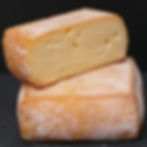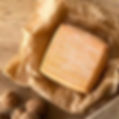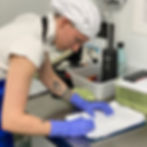What are the microbes in my cheese and what are they doing? - Part 1
- Sabrina Longley
- Oct 26, 2022
- 5 min read
Updated: Dec 6, 2022

We all know that Swiss cheese (such as Emmental) is full of holes, but what you may not know is that these holes are caused by bacteria. As any cheesemaker will tell you, bacteria, as well as other microbes such as yeasts and moulds, are largely responsible for the character, flavour, and appearance of their cheeses, but what are these microbes?
There are a variety of different microbes used in cheesemaking, all used in different ways and for different purposes that result in the creation of many different types of cheese. Some of these microbes are found in raw milk, some are added to the milk by the cheesemaker (these are referred to as “starter cultures”), and some are present in the cheese ageing rooms.

We will start with lactic acid bacteria (LAB), as they are arguably the most important microbes for cheesemaking. Their primary role is the fermentation of the milk which is done by the conversion of the sugars found in milk (the lactose) into lactic acid which enables preservation of the milk into cheese. We monitor the activity of these bacteria by measuring the pH at different intervals during the cheese-make, a lower pH indicates increased acidity which tells us that the LAB are working as they should.
This is important because by reducing the pH of the cheese we reduce the ability of disease-causing (pathogenic) organisms being able to grow and therefore make the cheese safe to eat. The reduction in pH also has a role in how the cheese forms, and therefore LAB can affect the texture of the cheese paste, as well as influencing flavour by the production of flavour compounds when certain fats and proteins present in the milk are broken down (1). LAB also produce bacteriocins which are antibiotics against certain other species of bacteria, for example they have been found to inhibit the growth of Listeria monocytogenes which can cause severe food poisoning (2). There are also types of Lactobacillus not used for their lactic acid producing properties, but rather for the flavours they produce in a cheese; Lactobacillus helveticus, for example, is a starter culture often used in hard cheeses such as parmesan and produces complex sweet and caramel flavours (3); however the use of L. helveticus in cheesemaking is controversial as some believe it is an ‘easy’ way to make good tasting cheese without needing to optimise other aspects of the cheesemaking and ageing processes. Others, like Lactobacillus acidophilus, are considered probiotics and are used in the production of yogurt (4).

So lactic acid bacteria are mostly important for the cheese-making process, but what about the microbes that influence the character of the cheese? Many of you are probably already familiar with the distinctive colour and smell of washed-rind cheeses. This is caused by the range of bacteria that grow on the rind, encouraged by the washing process.
One of the most notable of these bacteria is Brevibacterium linens (5), but this particular species of bacteria is only one of many that make up the complex micro-environment that exists on the surface of washed-rind cheeses. These include Brachybacterium, Staphylococcus, and Serratia species, among many others. Differences in which microbes are present on the rind will result in differences in the colour of the rind, from red to pink to orange to yellow tones and in the distinctive aromas emitted by washed-rind cheeses (6,7).
The act of washing the cheese in a salt solution (brine) will inhibit the growth of moulds growing on the surface and also help to spread the bacteria around the rind to create a nice even colour and texture; we wash Highmoor with a 3% salt solution which allows it to develop its distinctive appearance, flavour, and aroma. Some cheesemakers add alcoholic drinks to their brine which can further influence the taste and aromas given by the rind and can also result in a softer cheese; for example, Stinking Bishop is washed in a pear cider which gives it the aroma it is known for.
This practice stems from French monks in the Middle Ages who, in an effort to prevent spoilage of their cheeses by the moulds that grew in their cellars, washed them with what they had closest to hand; this tended to be beer or brandy, as clean drinking water was scarcer than either of these. Cheesemakers in the Alps at around the same time had similar problems with rind spoilage, and because clean drinking water was far more plentiful in the mountains they washed their cheeses with salt water instead of alcohol (8).

And now back to those bacteria in Swiss cheeses that produce their characteristic holes. Propionibacteria are added to the milk at the start of the make, and very early in the production process they produce carbon dioxide gas which creates holes. These are distinguishable from other holes that you may see in cheese, such as fissures between pieces of curd, due to the shine that you see on the inside of the holes and the perfect spherical shape. As well as producing holes in the cheese, the propionibacteria produce distinctive flavours due to the production of acetic and propionic acid which can differ between species of propionibacteria, and between strains of those species; in Highmoor we use a type that should produce fruity flavours (9).
So there you have it- a snapshot into some of the bacteria used in cheesemaking! Next month I will delve into the world of cheesemaking fungus, see you then!
References
1. Kongo JM, Kongo JM. Lactic Acid Bacteria as Starter-Cultures for Cheese Processing: Past, Present and Future Developments. Lact Acid Bact - R D Food, Heal Livest Purp [Internet]. 2013 Jan 30 [cited 2022 Oct 9]; Available from: https://www.intechopen.com/state.item.id
2. Aragon-Alegro LC, Lima EMF, Palcich G, Nunes TP, de Souza KLO, Martins CG, et al. Listeria monocytogenes inhibition by lactic acid bacteria and coliforms in Brazilian fresh white cheese. Braz J Microbiol [Internet]. 2021 Jun 1 [cited 2022 Oct 9];52(2):847–58. Available from: https://pubmed.ncbi.nlm.nih.gov/33462722/
3. Griffiths MW, Tellez AM. Lactobacillus helveticus: The proteolytic system. Front Microbiol. 2013;4(MAR):30.
4. Bull M, Plummer S, Marchesi J, Mahenthiralingam E. The life history of Lactobacillus acidophilus as a probiotic: a tale of revisionary taxonomy, misidentification and commercial success. FEMS Microbiol Lett [Internet]. 2013 Dec [cited 2022 Oct 14];349(2):77–87. Available from: https://pubmed.ncbi.nlm.nih.gov/24152174/
5. Rattray FP, Fox PF. Aspects of enzymology and biochemical properties of Brevibacterium linens relevant to cheese ripening: a review. J Dairy Sci [Internet]. 1999 [cited 2022 Oct 14];82(5):891–909. Available from: https://pubmed.ncbi.nlm.nih.gov/10342227/
6. Wolfe BE, Button JE, Santarelli M, Dutton RJ. Cheese rind communities provide tractable systems for in situ and in vitro studies of microbial diversity. Cell. 2014 Jul 17;158(2):422–33.
7. Beyond B. linens: How cheese rinds get their color - MicrobialFoods.org [Internet]. [cited 2022 Oct 14]. Available from: https://microbialfoods.org/beyond-b-linens-how-cheese-rinds-get-their-color/
8. El Soda M, Awad S. Cheese: Role of Specific Groups of Bacteria. Encycl Food Microbiol Second Ed. 2014 Apr 2;416–20.

_edited.jpg)